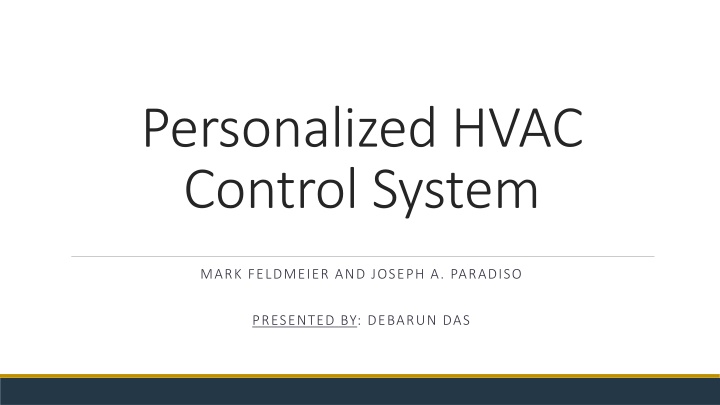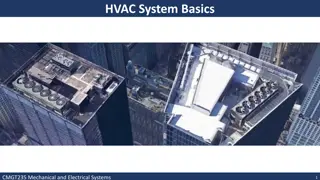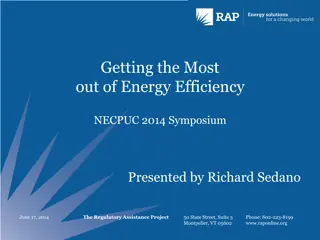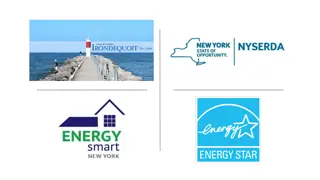Enhancing Energy Efficiency with Personalized HVAC Control System
Personalized HVAC Control System aims to optimize energy usage by sensing human comfort parameters, implementing control algorithms, and coordinating room nodes effectively. Motivated by high energy consumption in buildings, the system addresses user behavior towards thermostat settings to reduce energy wastage. Through a network of portable and control nodes, the system adapts to users' comfort preferences and environmental conditions, enhancing overall energy efficiency in both residential and commercial spaces.
Download Presentation

Please find below an Image/Link to download the presentation.
The content on the website is provided AS IS for your information and personal use only. It may not be sold, licensed, or shared on other websites without obtaining consent from the author.If you encounter any issues during the download, it is possible that the publisher has removed the file from their server.
You are allowed to download the files provided on this website for personal or commercial use, subject to the condition that they are used lawfully. All files are the property of their respective owners.
The content on the website is provided AS IS for your information and personal use only. It may not be sold, licensed, or shared on other websites without obtaining consent from the author.
E N D
Presentation Transcript
Personalized HVAC Control System MARK FELDMEIER AND JOSEPH A. PARADISO PRESENTED BY: DEBARUN DAS
Outline Motivation System Overview Algorithms Experimental Setup Evaluation Conclusion and Shortcomings Further Readings 2
Motivation Largest consumer of energy in buildings are the HVAC systems 26.1% and 53.4% of total energy usage in residential and commercial applications, respectively Usage of new, more efficient ventilation technologies are expensive Need to use existing technology more efficiently Lack of user comprehension of the behavior of HVAC systems Users tend to consistently over-turn thermostat dials in uncomfortable conditions Leads to energy wastage 3
System Overview Portable Nodes Sense parameters relevant to human temperature comfort Temperature, Humidity, Light Level, Activity Level Allows user to input current comfort state hot, cold, neutral Fixed versions gather internal and external local climate data Control Nodes Actuates air sources (windows and air conditioning dampers) Have a motor that opens/closes the corresponding mechanical component 4
Room Node Network Coordinator Receives data from portable and control nodes Helps infer locations of portable nodes from the RSS value Also sends local conditions (temperature, humidity etc) to the central network hub Central Network Hub Computer that receives all data over ethernet Processes data according to control and comfort algorithms Issues motor control commands to room nodes 5
Control Algorithms Control Module Receives setpoints from other modules Portable Module Keep tracks if a user is active Uses temperature Uses windowed mean and variance of piezoelectric motion sensor Collects user comfort level data on button press Location Module Locates Portable Nodes Based on strongest RSSI from room nodes Majority vote of past 3 readings smooth out the data Room Module Polls Location and Portable Modules Gives control to thermostat module when needed Detects room occupancy by using PIR motion sensor Thermostat Module Normal Room occupied but portable node not worn Setback Room unoccupied. Temperature raised Active Room occupied by people wearing portable node 7
Comfort Algorithm Need to measure Comfort Distance how far he/she is from being comfortable Constraints Insufficient data labels Reduced Data Set Indeterminate Data: Lack of even distribution of hot and cold labeled data Solution Robust Algorithm Does Not Overfit 9
Fishers Linear Discriminant Maximizes the separability among known categories Choose a decision boundary that maximizes ???????=?????????? ?? ????????? ????? ??? ?? ?????? ????? ????????? Representative training points have extreme values Normalization of Comfort Distance of a user Comfort Distance of the user divided by the mean Comfort Distance of all users 10
Experimental Setup Performed at MIT Media Laboratory Ten people, mostly graduate student population Four offices and common room area equipped with control nodes and room nodes Study conducted in three phases. Phase 1 Phase 3 Phase 2 No actuation Repairs done Hardware Evaluation Control System tested Periodic Surveys Week 2, 3, 4 Questionnaire Portable Node Feedback 11
Evaluation - Energy Metrics Energy usage measurement by air flow sensors in VAV boxes Average of Week 2 and Week 3 shows 75% decrease than Phase 2 Actual savings are much smaller Room 36 and 40 also cooled by 8 other non- controlled VAV boxes HVAC did not run properly in Phase 2 for all rooms Room 44 analyzed in detail Energy saving of 11.8% Average energy saving 24% 12
Conclusion and Shortcomings Managed to achieve energy savings of 24% over standard HVAC systems Shows considerable improvement in overall user comfort level The outside air is used for cooling only as the experiment is performed in the summer months The activity level thresholds are picked manually for different users after six weeks of user data Accelerometer could have provided more accurate activity level data Survey not fully reliable Small number of users Users mostly graduate students Should be performed across people of different age groups 14
Further Readings MarcoPritoni, KiernanSalmon, AngelaSanguinetti, JoshuaMorejohn, MarkModera, Occupant thermal feedback for improved efficiency in university buildings Vitor Mansur, Paulo Carreira, Artur Arsenio, A Learning Approach for Energy Efficiency Optimization by Occupancy Detection Alimohammad Rabbani, S. Keshav, The SPOT* Personal Thermal Comfort System 15























